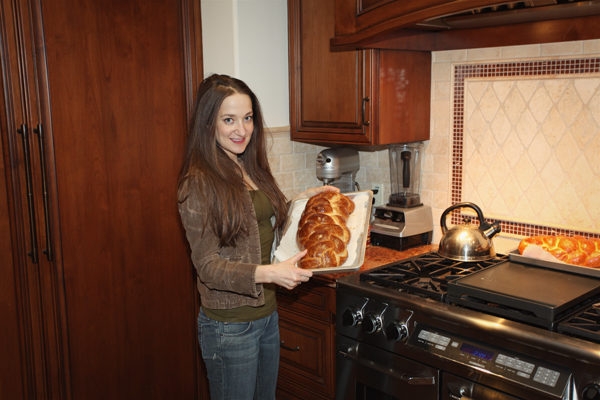Gluten-free friends and family, I have to apologize. This is NOT a g-free recipe.
There are certain things that people associate with their favorite holidays. For my Hungarian family, one of those things is Fonnot Kalács at Easter (or any holiday, really). It isn’t a type of bread that you can find at most bakeries. It is similar to challah, but slightly sweeter and less dense. I have been trying for a couple of years to find the right recipe and I’ve finally found it! I made three loaves for Easter this year. (Leftovers make a great base for French toast).
Fonnot Kalács (Hungarian Braided Sweet Bread)
Adapted from Gastronomer’s Giude
Dough Ingredients:
- 1 3/4 cups scalded milk
- 1 packet active dry yeast
- 5 Tablespoons sugar, divided
- 4 Tablespoons butter
- 1 teaspoon salt
- 2 large eggs
- 1 large egg yolk
- 5 to 6 cups all-purpose flour (depending on humidity)
Butter for brushing (4-8 Tablespoons unsalted butter)
Egg Wash
- 1 large egg, beaten, for egg wash
Directions:
- Set up a proof oven (I fill an 8”x8” cake pan with very hot water and stick it in my oven so that it gets nice and humid)
- Melt 4-8 Tablespoons of butter in a small saucepan.
- Using the melted butter, generously coat the inside of a large bowl (this is what you are going to use to raise your bread).
- Line a light bottomed baking sheet with parchment paper and brush the parchment with butter. Set aside.
- In a saucepan over medium heat, scald the milk.
- Put 1/4 cup of the scalded milk into a large bowl and allow it to cool until it is warm to the touch (about 110 degrees). Add 1 Tablespoon of sugar and the yeast. Let sit for 5-10 minutes until the yeast is foamy.
- Meanwhile, add butter to the remaining milk and stir to combine (the butter needs to melt completely).
- In a small bowl, beat together eggs, egg yolk, salt, and 4 Tablespoons (1/4 cup) sugar.
- Add the sugar/eggs mixture to the proofed yeast and stir with a wooden spoon to combine.
- Add in the milk mixture and stir.
- Mix in the flour, one cup at a time, until the dough is moist, but not sticky (I have never had to add more than 6 cups of flour).
- Using your hands, knead the dough inside of the bowl or on a floured surface for a couple of minutes.
- Form dough into a ball and place in the prepared buttered bowl. Brush the dough on all sides with butter.
- Cover your bowl with a very warm, damp dishcloth (just run your dishcloth under hot water and wring it out really well).
- Place the covered bowl into the proof oven.
- Allow dough to rise for 1 hour, or until doubled in size (you may have to change your proof oven water to keep it warm).
- After dough has risen for an hour, punch it down, recover and let it rise for another 30-45 minutes (it should double in size again).
- Remove everything from the oven and preheat the oven to 350 degrees Fahrenheit.
- Transfer dough to a floured work surface and knead a few times.
- Divide dough into six equal parts and braid into a six strand braid.
- Carefully transfer the braided dough to the prepared baking sheet.
- Brush the dough with butter and place in a warm place to rise for another 30 minutes.
- Beat the egg for the egg wash.
- Brush braided dough with egg wash, wait about two minutes to allow the egg to soak in and then brush it again, making sure that the dough is completely coated.
- Bake the bread at 350 degrees Fahrenheit for 35-45 minutes (it should be a nice golden brown).
- For best results, allow the bread to cool completely before slicing (but this bread is amazing hot…just saying).

